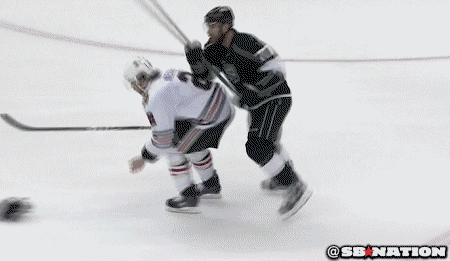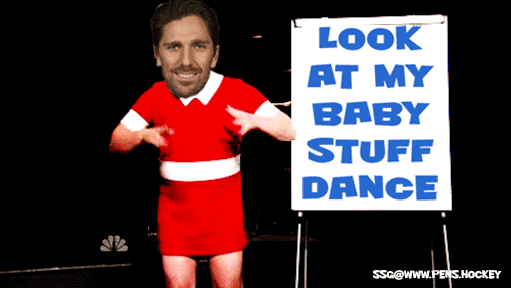A day after the NHLPA decided to let the current CBA continue for a few more years (translated: no strike until Crosby is 35), the NHL announced its annual amending of the rule book. According to the league, these rules were unanimously agreed on by the general managers in attendance. I originally posted these in the comments section but it was too much for some to read, and to be fair

They do deserve their own post
Rule 1: Helmets
If a players helmet comes off they must either leave the ice or retrieve it and put it on “in a reasonable amount of time.” The NHLPA has already filed for further clarification of this rule because “a reasonable amount of time” seems pretty subjective for a rule. As it is currently written “retrieve and put it on” is also loosely interpreted as putting the helmet on the head, but the chin strap does not have to be reattached properly if the player is still on the ice. The rule that could protect the players the most is the worst written, go figure.

Rule 2: Line Changes on Stoppages
2A: If a puck is dumped in from behind the center red line directly to the goaltender and the goalie freezes the puck the team sending the puck in won’t be allowed to change lines, call a timeout, and there will not be a tv timeout. Essentially this will be treated like an icing except for the location of the faceoff.
2B: If a defensive player knocks the net off the moorings without being pushed into the net by an opposing player the defending team will not be allowed to change lines before the upcoming faceoff. You know this move as the Drew Doughty Special. This includes the common situation where a defender chasing an offensive player on a breakaway makes a diving attempt and slides into the goal effectively removing it off the moorings. In this situation under the new rule that defensive player will stay on the ice along with all of his teammates.
Though the rule states “defensive player,” there is no ruling on what happens if a goaltender pisses his diaper and does it

Rule 3: New Faceoff Locations
3A- In the situation of icings, the line change rules described in 2A and 2B above, and the first faceoff of the powerplay, the offensive team will get to choose which side of the zone the faceoff will take place in. This is a rule designed to help fuel offense, and probably the most interesting rule change. Players are more likely to win their strong side faceoffs, a Lefty is more likely to win a faceoff in the left circle, and a righty on the right. Some players are anomalies and a coaches best friend, but for most of the NHL this conventional wisdom holds true. As of right now the Penguins have 6 players in their projected top 12 that play Center (Crosby, Malkin, Bjugstad, Blueger, McCann, Simon), of these only Bjugstad is a Righty. There are more Lefties than Righties in the league, which means more often than not a Penguin faceoff will take place on the left side, where the Penguin lefty will be on their strong side going up against an opposing teams lefty on his weak side.
3B- If the attacking team is responsible for the puck going out of play while in the attacking zone, the following faceoff will be at one of the two dots INSIDE the attacking zone. If you recall any game ever, every time the puck is shot out of play in the attacking zone the following seconds is full of a bunch of grown men pointing at each other like they are 5. This was because if the puck was deflected off of the defense and out of play the puck would stay in the zone for the following faceoff, where if it was shot out by the offensive team the faceoff would be outside the blue line. This change is another way to help increase offense, but I have a feeling it will be amended quickly. As of now, any puck that leaves the playing area in the attacking zone results in an offensive zone faceoff. This means that technically a player could purposely pull a Tyler Kennedy and shoot the puck out of play in order to earn a line change while keeping offensive zone possession. If I figured this out, players already have too, and I suspect this will change a bit.

Rule 4: New Use For Video Review
4A- Video Review will be used at the refs discretion to review high sticking double-minor penalties to ensure that the damage to the players face was actually caused by the stick. This review is entirely up to the ref, and if he feels he got the call right he does not have to use video to review the ruling. In the event of a video review, time will not be added to a penalty (i.e. if they see the stick hit and drew blood but they’ve already called it a minor), but penalty time can be reduced or negated if it is the proper call. When reviewing this video the ref will be supplied with all available angles, but the review will not involve the Toronto Situations Room, the call will be solely up to the referee.

4B- All Major (except fighting) and Match Penalties will be reviewed by the refs. Unlike the high-sticking situation above, referees will be required to review these situations. Again, the referee will be given all angles to amend the call on the ice but the Toronto Situation Room will not be involved. The referee can either confirm the major or match penalty or reduce the penalty to a 2-minute minor, negating the penalty outright is not allowed.
On both of these rules, I like that the NHL Situation Room isn’t being used, so hopefully, these reviews will help get the right call made while also not taking a century to conduct.

Rule 5: New Coaches Challenges
5- Coaches can now challenge 3 new situations on potential goals in addition to offsides and goalie interference: if a puck was played by a high stick while in the offensive zone prior to a goal being scored, if a puck was played by a hand pass in the offensive zone prior to a goal being scored, or if a puck hit the netting and should’ve been ruled out of play. In all of these situations, an event that SHOULD HAVE caused a stoppage in play before the goal was scored was missed. If the puck comes out of the offensive zone after any of these instances the play is considered “reset” and the challenge will be wasted.
The other change to the coaches challenge is the timeout is no longer the negotiating factor. In years prior, a team could only challenge if they had a timeout, and a lost challenge resulted in losing that timeout. This has changed, and teams can challenge whenever they want, with no limit on the number of challenges in a game. If a coach loses his 1st challenge it will result in a 2-minute minor, all missed challenges after the first will result in a double-minor. I really like this change, a team losing by 3 was more likely to challenge when all they could lose was a timeout. Now if you’re down by more than one you have to either A) really trust your video squad in the booth or B) really trust your penalty killers before making a challenge.
All coaches challenges will involve the NHL situation Room. This rule is good for teams like the Penguins who have an incredible video crew on hand and are usually pretty good with challenges. This rule is not good for coaches who think they are right but constantly lose challenges.

Rule 6: Goalies Can’t Lundqvist Anymore
6- If a goaltender deliberately knocks a goal post of the moorings during a breakaway it will result in an automatic goal for the attacking team. That is basically the rule as written, which seems to me the goaltenders “intent” will be at the refs discretion. An automatic goal is kind of steep if a goaltender uses the post to push off of and that happens to dislodge the net. Honestly though, this rule will probably result in like 1 goal this year so it’s not a big deal.

Rule 7: Does this even matter?
New rules are good for a league that is trying to change for the better. The question the fans want to know is will the refs actually use the rulebook or will games continue to be reffed based off of situations? Chess is a strategic game, you can’t decide which way each Rook can move during the game, it is set in the rules prior to beginning. Technically, the NHL is the same, but refs often use their own judgment based on the results of games, their childhood allegiances, or their emotions towards certain players to call the game. I appreciate changes to the rules, but all I really want is for the rules to be called as written in the rulebook.

